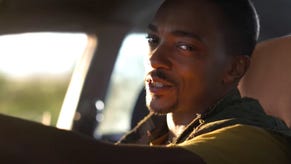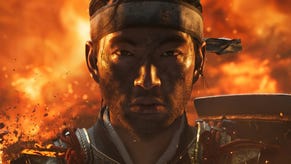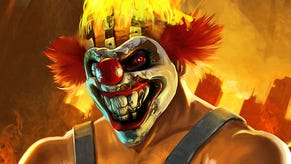Twisted Metal
Blow up Dolls.
From one angle it seemed like an odd choice to end the Sony conference with: a series that has faded from relevance, that had its last major outing all of nine years ago with 2001's Twisted Metal Black on PS2, and which has absolutely none of the cultured cool or mass-market Hollywood sweep with which Sony in particular likes to associate itself. Guns and cars, rust and destruction: this is an absolutely unreconstructed videogame.
But then, this is E3, and unreconstructed videogames tend to play pretty well here, especially (if far from exclusively) with the local crowd. Other things that play well here include affably rude creator David Jaffe, back at the helm of the series he created, and long-awaited returns of much-loved franchises. If Nintendo can unveil the 3DS with a Kid Icarus game, for heaven's sake, then Sony has every right to blow the trumpet about what is, in fact, the longest-running PlayStation-exclusive game series, going all the way back to 1995. The old warhorse has earned its spot.
Two days later, Jaffe is demonstrating the game to journalists first thing in the morning in more serene surroundings, a quiet Sony demonstration room far from the show floor. Down there you can get hands-on with a straight team deathmatch mode - more on that later - but up here he's demonstrating that Twisted Metal's multiplayer has considerably more scale, depth and ambition than you might expect, by showing Nuke mode.
(Single-player is off the menu for Twisted Metal's E3 debut. Jaffe will only say that it involves "individual characters that go through stories" rather than multiplayer's faction-based set-up).
Nuke is intended to encourage a more tactical, organised, almost class-based style of team combat that will draw out the interplay between the different vehicles' skill sets and get clans involved and strategising. "We've always thought of it as a fighting game in cars, like Mortal Kombat," says Jaffe, but this objective mode with its unusual mechanics is more like a basket-case Battlefield.

In a smouldering, wrecked downtown cityscape, the two factions of Clowns and the Dolls are trying to destroy giant statues of respective faction leaders Sweet Tooth and Doll Face. Brilliantly, these 15-storey floodlit effigies are suspended from helicopter transports and being flown slowly around the map. Twisted Metal is an ugly game - on at least one level, it's meant to be - but there's no denying that this is a wonderfully tasteless spectacle.
Elsewhere on the map, each team has a missile launcher, and the two actual leaders are manning turrets on foot. The aim of the game is to get to the enemy faction leader, kidnap them and take them to a hot zone next to your faction's missile launcher. Keep the leader in that zone's perimeter long enough and you'll charge your launcher, at which point you can start firing player-guided missiles at the opposing team's statue. It's not all over yet, though, because these are relatively easy for the helicopter's minigun, or a missile-equipped ground vehicle, to take down.
It looks like a fun, progressive dynamic for a multiplayer match which exploits the large scale and impressive verticality of the city map. Although Jaffe began by using the chopper to fly around the map and explain the mode, he transferred to a heavily modified old sedan called the Road Boat to play a good chunk of the demonstration. He was still able to climb up through parking lots, use ramps and building interiors and blow through walls to access high vantage points for sniping (an automatic lock and zoom - real sniping is just too hard in cars, apparently), or to get to the raised platform to defend his faction chief Doll Face.
Every faction can drive every vehicle - even Sweet Tooth's truck, which now transforms into a robot - and there should be 12 to 16 in all, with around half of them being new and half familiar from previous instalments.
In order to achieve the aim of getting every car to feel like a fighting-game character, they all have different characteristics across a huge range - armour, handling, carrying capacity, energy refill for energy abilities (shield, mine, and so on), turbo drain, radar signature range. But the key differentiators are, of course, their over-the-top specials.








